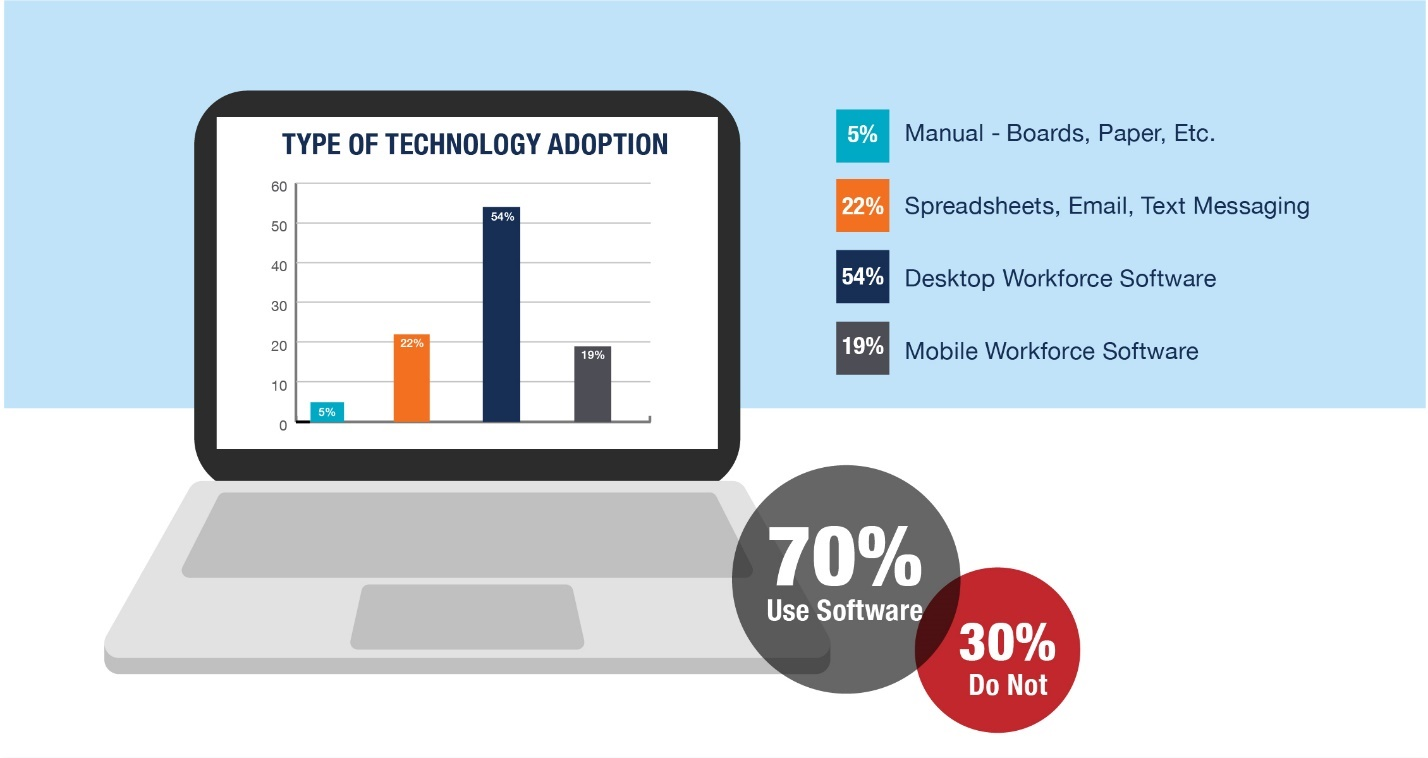Top Trends in Addressing Operational Challenges Through Technology in Physical Security

In the Security Guard industry, there is a tremendous level of complexity and market factors that are creating various challenges to reduce costs, improve profitability and operate in the most efficient manner possible. It’s one thing to theorize about market challenges and make assumptions, however, it is far more valuable and insightful to take a more quantitative approach and analyze data points to examine trends in security guard operations.
This is exactly what we did. Pulling from a recent survey of guarding firms in the U.S., we compiled a comprehensive set of data to outlines not only the key challenges facing guard companies today, but also look at how technology is becoming a mitigating factor in their operations.
Compiling a data set from a wide range of Security Guard Companies ranging in size and scope, we were able to uncover some interesting trends in operations that provide some insight into key challenges and opportunities within the market.
Top Challenges facing Guard Firms: Turnover remains the Biggest Factor
When analyzing the data, one of the questions asked centered around what the biggest operational challenges that are facing security guard firms today:

The result was that the majority of guard firms cited turnover as one of the most consistent threats facing their business. The ability to not only attract new talent but retain talent is one of the largest challenges in the industry.
The second and third major points are margins and profitability, followed by non-billable overtime. However, it’s important to note and surmise that one challenge can clearly lead into another. Without the right amount of resources to work a post, companies are forced to post guards that may be over hours and will ultimately incur non-billable overtime. Since they cannot bill for that time, this can cut into their overall margins and profitability:

So in effect – turnover can be a catalyst for other challenges within an operation. So what are companies doing today to mitigate this risk of turnover?
Addressing Turnover: Analysis of How Companies are Sourcing Talent and Retaining Resources
With an overwhelming competitive wage market, guarding firms are not just faced with competitive turnover – losing to another peer – but also turnover to other industries. Favorable wage rates and a historically low unemployment rate contribute to resources simply leaving the industry altogether to seek better pay rates. This is a major challenge to try and offer a competitive rate for a job that demands more of its employees for security and safety of a client.
Retail is one of the largest competitive threats to the guarding industry today – the wage rates and fringe benefits from “big box” retail chains can impact the ability to retain talent, and security firms are forced to maintain competitive wage rates to keep staff on the payroll. Ultimately, this cuts into their margins, which can force a company to seek efficiencies in operations.
How are firms sourcing and retaining new applicants? And how much is spent in their overall budget to recruit and onboard resources? This becomes a data point that can illustrate the level of effort required to keep the turnover trend at bay.
We looked at this, and asked how most guard firms find and recruit new talent:

What’s interesting is the wide range of options that are employed by security guard firms. This indicates that there is no “magic bullet” in terms of recruiting talent; companies are trying various different ways to build their applicant pool. Forty-five percent of firms are using some sort of digital outreach, whether through job boards or digital classified ads, while another 27 percent are leveraging more traditional HR teams and recruiters to seek out applicants.
Perhaps the most interesting factor is the 26 percent that stated referrals still are a major source of their recruitment methods. This is particularly of note in that referrals can be a lower cost source of recruitment and often can help to alleviate the burden of building a talent pool through paid methods. Whether this is employee referral or client referral, it still stands to reason that security firms still have the ability to attract talent through this method.
What’s not outlined in the figure above is the actual cost to that is incurred for each employee that is hired. Looking at the same group, we asked what the average employee cost per month to hire and onboard, including the cost of the recruiting methods, training and onboarding:

As you can see, the figures are fairly split evenly, ranging from under $100 to over $300 per month per employee to attract, hire and onboard new talent. This isn’t completely surprising, considering that there is a need to keep hiring costs low. What isn’t factored into this data point is understanding how turnover can impact your costs. For Example, if it costs you $100/employee/month to hire a new employee, and you have a 50 percent turnover rate, then for every $100 you spend on one employee, $50 of that is lost due to turnover. So you cost to hire an employee is really $150/employee/month with turnover factored into it. This is not a calculation most operators consider, and turnover rates need to be factored into the cost to hire.
Technology Adoption as a Means to Streamline Operations Amidst Challenges
What we’ve seen is that security guard firms are faced with challenges that contribute to their overall bottom line. Higher turnover will force an organization to absorb costs in recruiting and onboarding. Competitive job markets are driving higher wage rates to ensure an acceptable retention rate. Yet with all these factors, turnover can still trickle down to forcing potential non billable overtime, driving into overall margins. As a result of this cascading effect, companies are turning towards other methods to help achieve efficiencies and streamline their operations. One of those is in technology adoption.

Looking at technology as a driver for many companies, we are seeing that the majority of guard firms have some level of software solution to help them manage their workforce. Of the respondents, around 70 percent state that they are using software solutions in their business. Digging deeper into the data, the majority of guard firms are using true software solutions for their operations:

Mobility and Guard Workforce Management – A growing trend

Part of the attraction of a software solution is that it provides a level of automation that eliminates manual entry, data errors, and gives companies a much better way to streamline operations and reduce costs. Another important aspect is usability. Companies want to adopt solutions that will drive value, and leverage a platform that is familiar to their end users. Of the firms that have adopted technology, 74 percent are using a mobility technology to augment operations.
One of the powerful aspects of mobile is the ability to drive further value to get real-time information on operations. By having these real-time operational aspects tracked, it’s a lot more beneficial to drive costs down and manage schedules more effectively. Below is a drill-down on how companies are leveraging mobile technology:

The majority of these mobile functions contribute to the ability to access real-time activities within the context of operations. This means being able to track the time worked, the activities within that time period, any incidents that might impact operations, and being able to gain visibility and control over those activities. Data from mobile helps to create a larger view into operational efficiency, and allows business to see any impact of these operations on costs and profit margins.
Conclusion: Building a Strategy to Offset Challenges
In this article, we’ve seen some interesting data points around the top challenges facing the Security Guard industry. Perhaps the biggest of which could be considered a catalyst for many other challenges, and that is Turnover and Retention. If you look at the data, an overwhelming number of respondents see turnover as a major challenge to maintaining operations within their business. With an increasing competitive job market, many security firms are not only competing with their peers for resources, but also other industries, such as retail, for a share of the job market.
The challenge of turnover can impact the business from multiple facets. If an organization has limited resources, they may be forced to post guards that are over hours, which impacts non-billable overtime. In turn, incurring non-billable overtime will ultimate cut into margins and impact profitability. So one challenge bleeds into another.
With turnover as a constant challenge, companies need to look to other ways to help streamline operations, reduce costs and maximize their margins. Most of this comes through technology adoption, specifically around solutions that combine both Web-based and mobile solutions. The primary focus for technology in alleviating operational constraints is to reduce the manual effort associated with maintaining schedules, optimize scheduling to provide a better allocation of billable resources, all with the goal of offsetting additional costs to ensure margins are as optimal as possible.
Looking for a reprint of this article?
From high-res PDFs to custom plaques, order your copy today!






